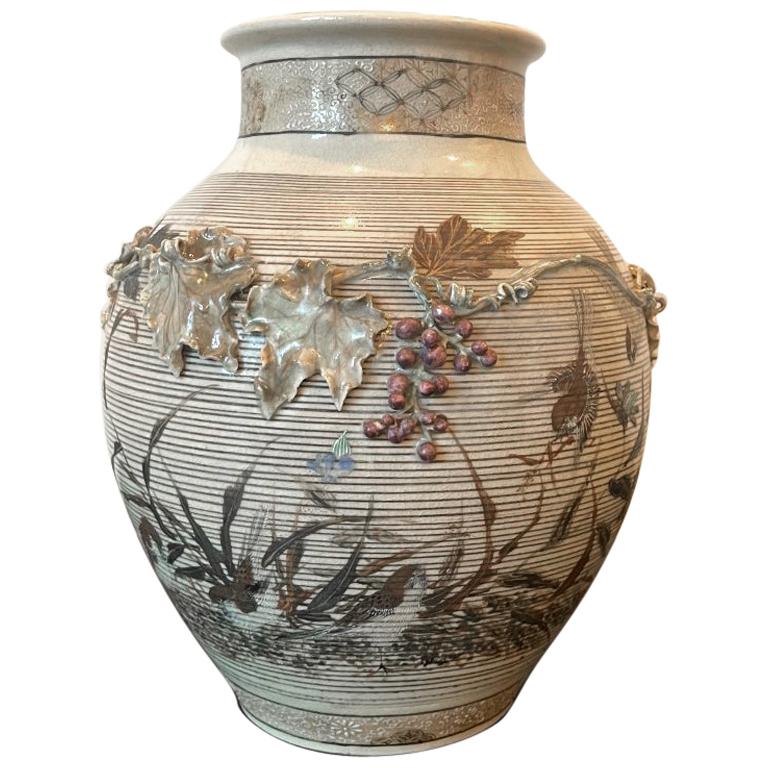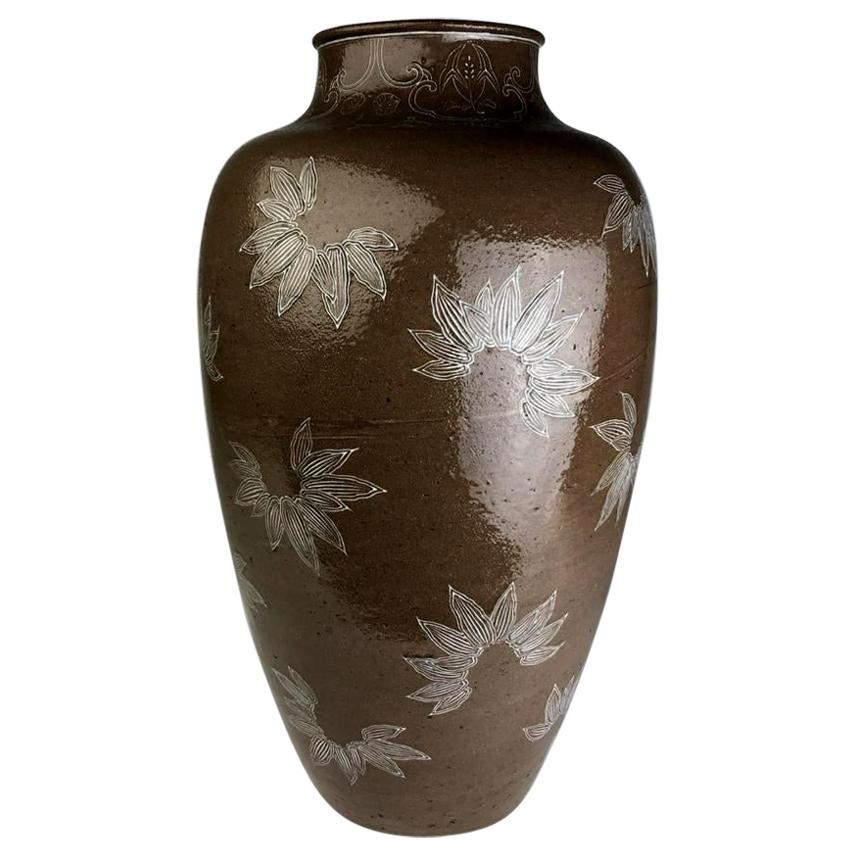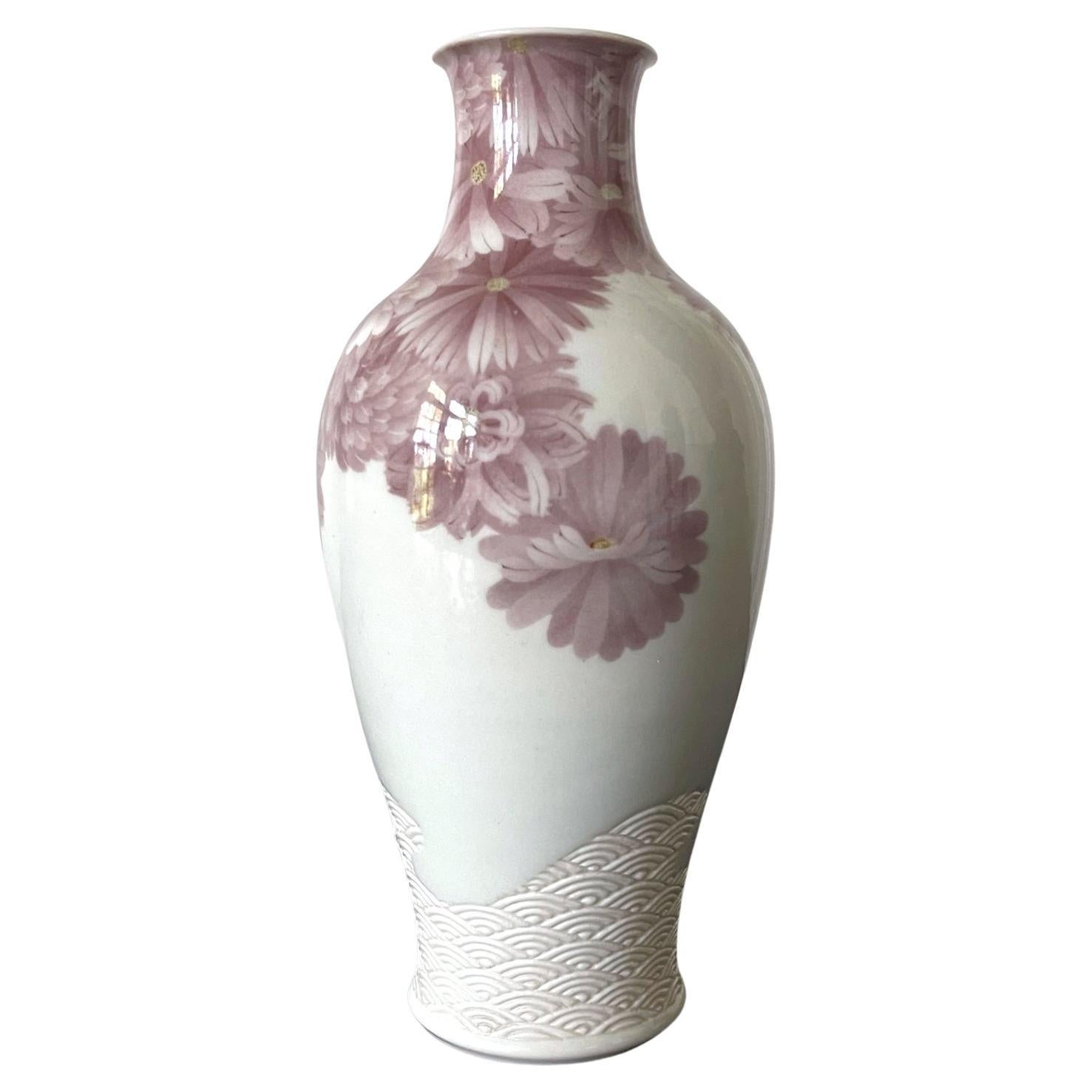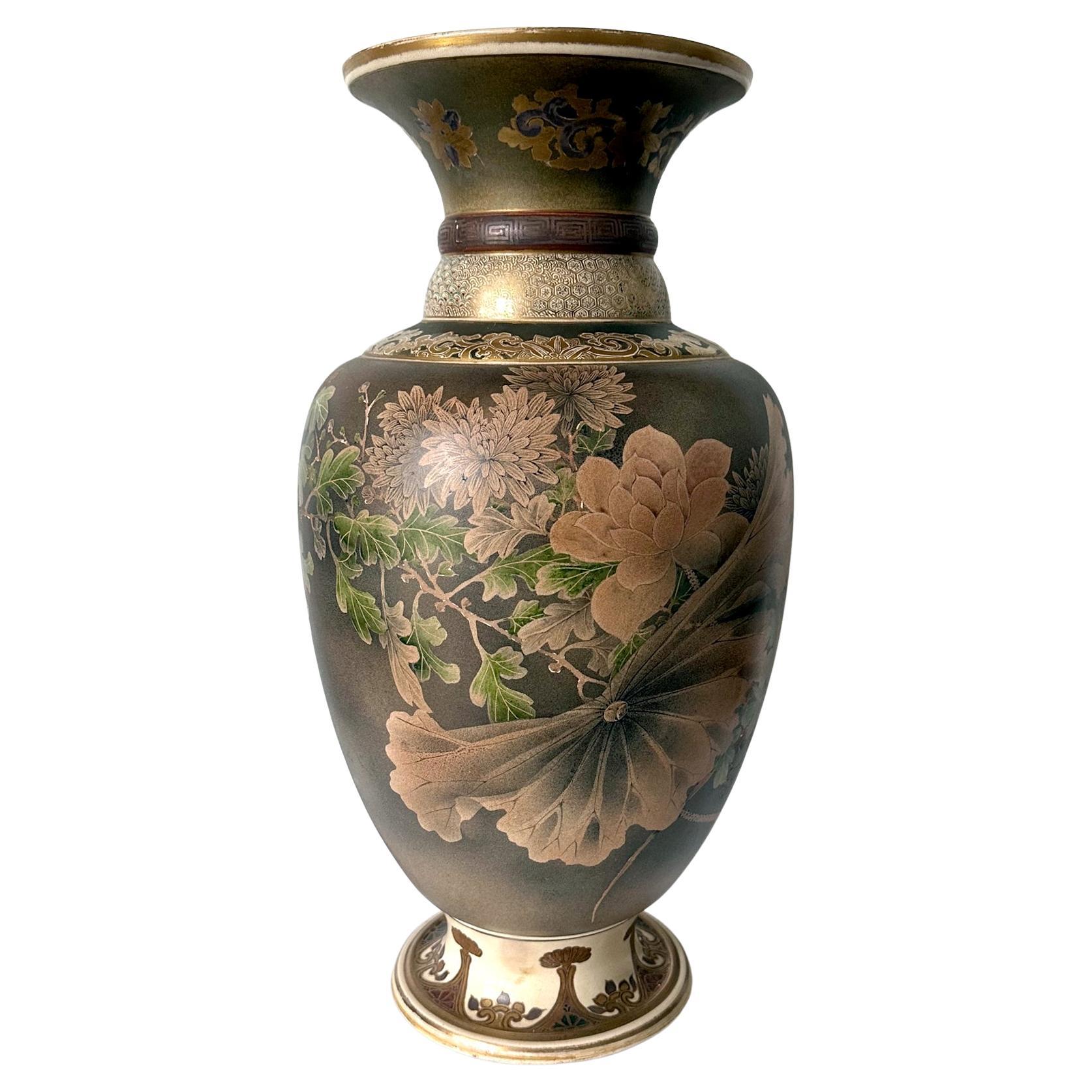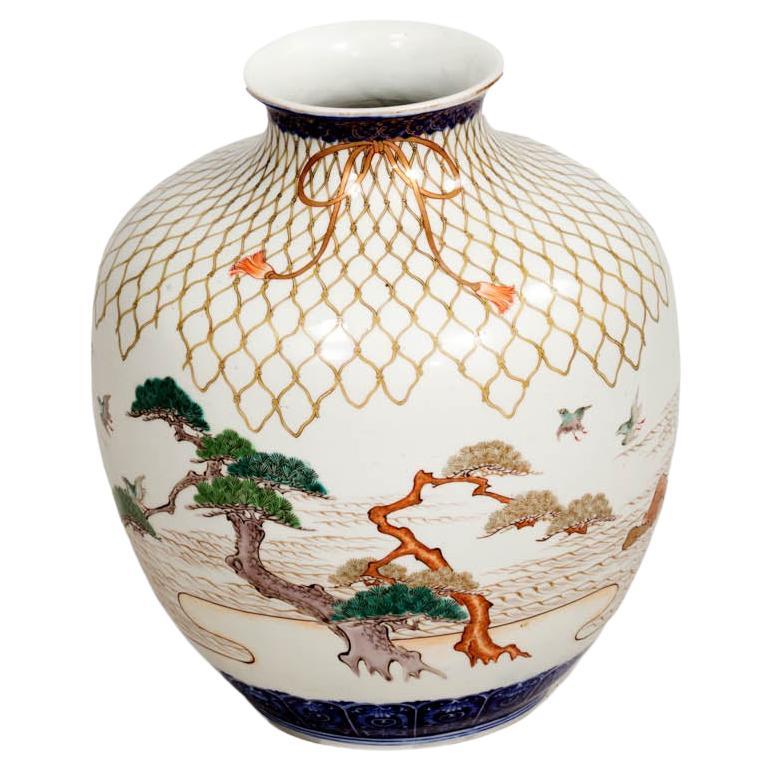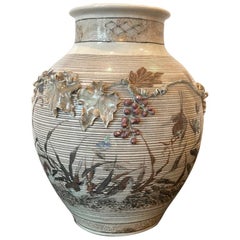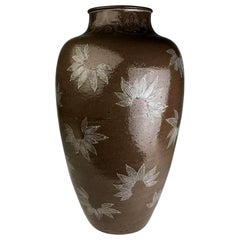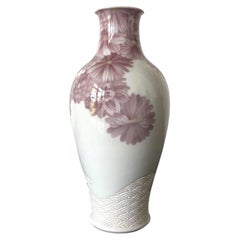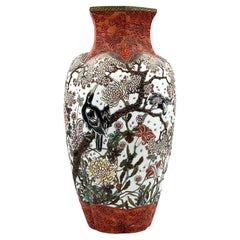Items Similar to Japanese Ceramic Vase by Ito Tozan I Meiji Period
Want more images or videos?
Request additional images or videos from the seller
1 of 13
Japanese Ceramic Vase by Ito Tozan I Meiji Period
$5,000
£3,710.19
€4,321.87
CA$6,960.04
A$7,750.63
CHF 4,033.77
MX$95,564.31
NOK 51,373.19
SEK 48,285.82
DKK 32,246.49
Shipping
Retrieving quote...The 1stDibs Promise:
Authenticity Guarantee,
Money-Back Guarantee,
24-Hour Cancellation
About the Item
This stoneware vase of a jar form was finely decorated with low relief carving and delicate colored glazes depicting bundles of peony flowers. It was made by Ito Tozan I (1846-1920) circa 1890-1900s in the late Meiji Period. The color pallet was both bold and subtle, with dark green and rusty leaves with golden outlines and white and light yellow peony petals covering much of the surface. Impressed with potter's mark on the base.
Examples of two pieces by Ito Tozan I were in the collection of MNAAG (Guimet) Paris. Inventory no. MG 13790 an 13792.
A vase with similar shape and decoration techniques is featured as Lot 1340 Fine Japanese Art, 13 Sep 2017 Bonhams New York
Tozan Ito I established his ceramic business in Kyoto 1867. His studio made both porcelain and stoneware in a style some considered Satsuma while they retained a sophistication of Kyoto ware. His work often feature techniques such as carving, slip painting to create a textured decoration on the surface. The line was continued by his adopted son Ito Tozan II and ended at Ito Tozan III in 1970s. Ito Tozan II and III also marked their ware with Tozan but with slight variations.
Biography of Ito Tozan I:
"Born in the Awata district of Kyoto, Ito Tozan I began to study painting at the age of 12 under Koizumi Togaku. Togaku and his wife pursued the production of tea bowls and decorated hand-molded earthenware teapots. In 1863, Tozan followed his teacher into the world of ceramics and began studying under Kameya Kyokutei. In addition Tozan I studied the work of such artists as Takahashi Dohachi III, Murata Kisui, Kanzan Denshichi, Obiyama Yohei, Hitomojiya Chubei and Iwakura Kahei. In 1867, he constructed a shop alongside the Shirokawa River close to the Gion District. Tozan I exhibited frequently, winning prizes in Amsterdam (1883), Paris (1889), Chicago (1893), the 4th National Industrial Exposition (1895), Paris (1900), and the 5th National Industrial Exposition (1903). In 1899, he was awarded the Ryokuju Hosho (Green Ribbon Medal), and in 1909, he moved his shop to Sanjo Shirakawa-suji. In 1912, he received the go or art name To-o (the Old Man of Pottery) along with gold and silver seals from Lord Kuninomiya Kuniyoshi. In Taisho 6 or 1917, he was appointed a Teishitsu Gigeiin or an Imperial Artist. In 1919, he assisted in the revival of OMI Zeze pottery, constructing a kiln in the Eastern Yamashina district of Kyoto. This kiln was first fired on July 9th of 1920, and Tozan I passed away three days later at the age of 76.
Ito Tozan I was a leading figure in the Kyoto ceramics world during the Meiji and Taisho eras. His work is in the collections of Museum of Fine Arts, Boston, the Victoria and Albert Museum, and the Tokyo National Museum."
From Khalili collection of Japanese Art.
- Creator:Ito Tozan I (Artist)
- Dimensions:Height: 8.5 in (21.59 cm)Diameter: 6.5 in (16.51 cm)
- Style:Japonisme (Of the Period)
- Materials and Techniques:
- Place of Origin:
- Period:
- Date of Manufacture:1890-1900s
- Condition:Wear consistent with age and use. Minor surface wear commensurate with age.
- Seller Location:Atlanta, GA
- Reference Number:1stDibs: LU945014583751
About the Seller
4.9
Platinum Seller
Premium sellers with a 4.7+ rating and 24-hour response times
Established in 2006
1stDibs seller since 2010
561 sales on 1stDibs
Typical response time: <1 hour
- ShippingRetrieving quote...Shipping from: Atlanta, GA
- Return Policy
Authenticity Guarantee
In the unlikely event there’s an issue with an item’s authenticity, contact us within 1 year for a full refund. DetailsMoney-Back Guarantee
If your item is not as described, is damaged in transit, or does not arrive, contact us within 7 days for a full refund. Details24-Hour Cancellation
You have a 24-hour grace period in which to reconsider your purchase, with no questions asked.Vetted Professional Sellers
Our world-class sellers must adhere to strict standards for service and quality, maintaining the integrity of our listings.Price-Match Guarantee
If you find that a seller listed the same item for a lower price elsewhere, we’ll match it.Trusted Global Delivery
Our best-in-class carrier network provides specialized shipping options worldwide, including custom delivery.More From This Seller
View AllJapanese Porcelain Vase with Relief Surface Makuzu Kozan
By Makuzu Kozan
Located in Atlanta, GA
A rare porcelain vase by Makuzu Kozan (1842-1916) circa 1870-81 (late Meiji period). The vase is dated to the earlier work from Kozan's studio during his early period (Takauki-ware p...
Category
Antique Late 19th Century Japanese Japonisme Ceramics
Materials
Ceramic
Rare Large Vase with White Slip Inlay Makuzu Kozan Meiji Period
By Makuzu Kozan
Located in Atlanta, GA
A impressively large and unusual stoneware vase in an urn shape from the studio of Japanese Potter Makuzu Kozan, also known as Miyagawa Kozan (1842–1916), one of the most established and collected ceramist from Meiji Period. Born as Miyagawa Toranosuke, Kozan established his pottery studio in Yokohama circa 1870s and later became one of the appointed artist to the Japanese Imperial household. His work was exhibited in many international fairs that the Meiji government participated at the turn of the century and won many grand prizes.
This vase is dated to the end of Makuzu's life circa 1910-1916 based on similar work created around that time. After achieving domestic and international fame, Makuzu retired and handed the business to his son Hanzan in 1912. He dedicated his time to other selected projects that were more in tune with Japanese sensibility than export aesthetic. He made a group of stoneware pottery pieces inspired by Edo master like Ninsei and Kenzan as well as his own poetic creation. This piece is attributed to that period.
Standing of an impressive size, this vase is more like an urn, made with stoneware instead of porcelain. It was coated with a brown iron glaze with a slight translucent quality. Underglaze whit slips were used to draw low relief decoration of bamboo leaves that sparsely scatter on the surface. Slightly more elaborate scrolling vines and autumn flowers circles under the mouth rim. Same white slip inlay was used to sign the vase under the base. The whole effect of the piece is unusual. With its dark glaze in contrast with the sparse white decoration that is more abstract and geometric than realistic, it appears almost modern with an Art Deco flavor.
For stoneware urn and vase in the similar genre by Makuzu Kozan: see figure 113 on page 182 of "Sekai ni Aisa Reta ya Kimono" MIYAGAWA KOZAN MAKUZU...
Category
Vintage 1910s Japanese Japonisme Ceramics
Materials
Ceramic
Japanese Ceramic Vase with Delicate Carvings by Makuzu Kozan Meiji Period
By Makuzu Kozan
Located in Atlanta, GA
A delicate and rare Japanese ceramic vase by the important Meiji imperial potter Makuzu Kozan (1842-1916) circa 1887-1910. Dated to his underglaze phase post 1887 after he successful...
Category
Antique 1890s Japanese Japonisme Ceramics
Materials
Ceramic
Large Japanese Satsuma Ceramic Vase Kinkozan
By Kinkozan
Located in Atlanta, GA
A large Japanese ceramic vase from the end of Meiji period circa 1890-1910s by Kinkozan (1645-1927). One of the largest studio manufacturers of the export ceramics at the time based in Kyoto. In the typical style of satsuma made at the turn of 20th century, the vase is elaborately decorated with a rather unusual kinran-de (gold paint) and green enamel highlight on a mottled brown background. The painterly decoration depicts a large seasonal floral arrangement in a circular fashion. Besides the obviously superb craftsmanship, what sets this particular vase apart from many lower quality and mass-produced pieces is its tone-on-tone color pallet that is visually somber and the small and sensitive details that heralds the change of the seasons. When the viewer goes beyond the first casual glimpse of the blossom and foliage, one would notice that on the edges of certain leaves as well as along the stalks, there accumulates a very thin layer of the white dust that represents the frost. The flower in bloom are chrysanthemums. Despite of being splendid, they are the messengers of the autumn. The large lotus leaf was subtly rendered in a bended and slightly withered manner, just past its prime. Although the lotus is still in bloom, the prominent seed pod indicates it may be the last for the season. The sentimental capture of the change of the seasons is not unusual in Japanese art. This vase poetically represents such a subtle transition from summer to fall, perhaps depicting the very first frost.
The neck of the vase is also slightly unusual with two rolled rings...
Category
Early 20th Century Japanese Meiji Ceramics
Materials
Ceramic
Large Japanese Ceramic Vase by Makuzu Kozan Meiji Period
By Makuzu Kozan
Located in Atlanta, GA
A large Japanese ceramic vase by the celebrated Meiji imperial potter Makuzu Kozan (1842-1916) circa 1880-1890s. Dated to his underglaze phase post 1887 after he successfully mastered the new colors available from the west and used them to the best advantage in his work deeply rooted in Japanese aesthetics. The vase has an impressive size and was potted in the classic baluster form with an elegant proportion. The surface is decorated using a combination of techniques of low relief sculpturing...
Category
Antique Late 19th Century Japanese Meiji Ceramics
Materials
Ceramic
Japanese Porcelain Vase Meiji Period Makuzu Kozan
By Makuzu Kozan
Located in Atlanta, GA
A finely decorated and glazed Japanese porcelain vase by Makuzu Kozan (1842-1916) circa 1900s Meiji Period. The vase is of a classic bottle form with baluster body and short neck. It was decorated with underglaze white magnolia blossom on a pleasant celadon background. The stamens of the flower were artistically rendered in a low relief, giving the design a realistic appeal with the dimension.
Miyagawa Kozan...
Category
Early 20th Century Japanese Meiji Ceramics
Materials
Porcelain
You May Also Like
Late 19th Century Chinese Ceramic Vase in the Japanese Style
Located in Dublin 8, IE
Late 19th century Chinese ceramic vase in the Japanese style, bulbous in shape with painted naturalistic detailing of trees, water, and birds. Solid deep blue banding highlights the ...
Category
Antique Late 19th Century Asian Ceramics
Materials
Ceramic
Japanese Meiji Period Porcelain Vase by Shimazu Gyokuzan, Ca. 1890
Located in New York, NY
Japanese Meiji Period Porcelain Vase by Shimazu Gyokuzan, Ca. 1890
DIMENSIONS
Height: 18.5 INCHES
Diameter: 9 inches
DETAILS
Meiji Period (1868 -1912) – Ca.18...
Category
Antique 1890s Japanese Japonisme Vases
Materials
Porcelain
Porcelain Vase by Japanese Master Artist
Located in Takarazuka, JP
Exquisite Japanese contemporary porcelain decorative vase, hand painted in vivid blue and red on an elegant bottle shape body, a signed piece by highly acclaimed Japanese master porc...
Category
21st Century and Contemporary Japanese Meiji Vases
Materials
Gold
Antique Meiji Period Japanese Satsuma Vase Floral Decoration, 19th Century
Located in Amsterdam, Noord Holland
Fabulous Japanese earthenware Satsuma Vase with nice decoration of flowers. Meiji period, 19/20th c
Lovely piece.
Additional information:
Material: Porcelain & Pottery
Japanese Sty...
Category
Antique 19th Century Japanese Meiji Vases
Materials
Porcelain
Lovely Japanese Porcelain Antique Vase in Flowers Marked, 19th Century
Located in Amsterdam, Noord Holland
Sharing this lovely brown vase with beautiful glaze. It’s in the shae of a kalebas. Marked at the base.
Additional information:
Material: Porcelain & Pottery
Region of Origin: Japan...
Category
Antique 19th Century Japanese Meiji Vases
Materials
Porcelain
Japanese Meji Period Satsuma Vase c1885
Located in Tunbridge Wells, GB
Heading : Japanese Meji period satsuma vase
Date : c1885
Origin : Japan - possibly Satsuma province although most likely decorated in Kobe or Yokohama.
Bowl Features : Imari palette ...
Category
Antique 1880s Japanese Porcelain
Materials
Porcelain
More Ways To Browse
Kiln Japanese
Japanese Peony
Meiji Figure
Ceramic Flower Relief
Teapot Japan
Japanese Green Pottery
1883 Vase
Antique Japanese Stoneware
Green Jar Japan
Japanese Meiji Period Silver Vase
Antique Industrial Molds
Kyoto Vase
Antique Pottery Teapots
Japanese Silver Teapot
Tokyo Japan Vase
Albert Green Ceramics
Antique Gold Teapot
Antique Tea Jar
